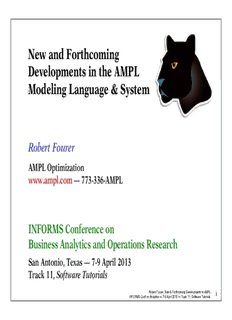Table Of ContentNew and Forthcoming
Developments in the AMPL
Modeling Language & System
Robert Fourer
AMPL Optimization
www.ampl.com — 773-336-AMPL
INFORMS Conference on
Business Analytics and Operations Research
San Antonio, Texas — 7-9 April 2013
Track 11, Software Tutorials
Robert Fourer, New & Forthcoming Developments in AMPL 1
INFORMS Confon Analytics —7-9 April 2013 —Track 11, Software Tutorials
Outline
Essentials
Why AMPL?
AMPL’s users
Enhancements: Building & maintaining models
More natural formulations
Logical conditions
Quadratic constraints
Integrated development environment (AMPL IDE)
Enhancements: Deploying models
Application programming interfaces (AMPL API)
C++, Java, .NET, Python
MATLAB, R
Robert Fourer, New & Forthcoming Developments in AMPL 3
INFORMS Confon Analytics —7-9 April 2013 —Track 11, Software Tutorials
The Optimization Modeling Cycle
Steps
Communicate with problem owner
Build model
Prepare data
Generate optimization problem
Submit problem to solver
CPLEX, Gurobi, Xpress, KNITRO, CONOPT, MINOS, . . .
Report & analyze results
Repeat!
Goals
Do this quickly and reliably
Get results before client loses interest
Deploy for application
Robert Fourer, New & Forthcoming Developments in AMPL 5
INFORMS Confon Analytics —7-9 April 2013 —Track 11, Software Tutorials
What Makes This Hard?
“We do not feel that the linear programming user’s
most pressing need over the next few years is for a
new optimizer that runs twice as fast on a machine
that costs half as much (although this will probably
happen). Cost of optimization is just not the
dominant barrier to LP model implementation.
“The process required to manage the data,
formulate and build the model, report on and
analyze the results costs far more, and is much more
of a barrier to effective use of LP, than the
cost/performance of the optimizer.”
Krabek, Sjoquist, Sommer,
“The APEX Systems: Past and Future.”
SIGMAP Bulletin 29 (April 1980) 3-23.
Robert Fourer, New & Forthcoming Developments in AMPL 6
INFORMS Confon Analytics —7-9 April 2013 —Track 11, Software Tutorials
Optimization Modeling Languages
Two forms of an optimization problem
Modeler’s form
Mathematical description, easy for people to work with
Algorithm’s form
Explicit data structure, easy for solvers to compute with
Idea of a modeling language
A computer-readable modeler’s form
You write optimization problems in a modeling language
Computers translate to algorithm’s form for solution
Advantages of a modeling language
Faster modeling cycles
More reliable modeling and maintenance
Robert Fourer, New & Forthcoming Developments in AMPL 7
INFORMS Confon Analytics —7-9 April 2013 —Track 11, Software Tutorials
Algebraic Modeling Languages
Formulation concept
Define data in terms of sets & parameters
Analogous to database keys & records
Define decision variables
Minimize or maximize a function of decision variables
Subject to equations or inequalities
that constrain the values of the variables
Advantages
Familiar
Powerful
Implemented
Robert Fourer, New & Forthcoming Developments in AMPL 8
INFORMS Confon Analytics —7-9 April 2013 —Track 11, Software Tutorials
The AMPL Modeling Language
Features
Algebraic modeling language
Variety of data sources
Connections to all solver features
Interactive and scripted control
Advantages
Powerful, general expressions
Natural, easy-to-learn design
Efficient processing scales well with problem size
Robert Fourer, New & Forthcoming Developments in AMPL 9
INFORMS Confon Analytics —7-9 April 2013 —Track 11, Software Tutorials
Introductory Example
Multicommodity transportation . . .
Products available at factories
Products needed at stores
Plan shipments at lowest cost
. . . with practical restrictions
Cost has fixed and variables parts
Shipments cannot be too small
Factories cannot serve too many stores
Robert Fourer, New & Forthcoming Developments in AMPL 10
INFORMS Confon Analytics —7-9 April 2013 —Track 11, Software Tutorials
Multicommodity Transportation
Given
(cid:1841) Set of origins (factories)
(cid:1830) Set of destinations (stores)
(cid:1842) Set of products
and
(cid:1853) Amount available, for each (cid:1861) ∈ (cid:1841) and (cid:1868) ∈ (cid:1842)
(cid:3036)(cid:3043)
(cid:1854) Amount required, for each (cid:1862) ∈ (cid:1830) and (cid:1868) ∈ (cid:1842)
(cid:3037)(cid:3043)
(cid:1864) Limit on total shipments, for each (cid:1861) ∈ (cid:1841) and (cid:1862) ∈ (cid:1830)
(cid:1861)(cid:1862)
(cid:1855) Shipping cost per unit, for each (cid:1861) ∈ (cid:1841), (cid:1862) ∈ (cid:1830), (cid:1868) ∈ (cid:1842)
(cid:1861)(cid:1862)(cid:1868)
(cid:1856) Fixed cost for shipping any amount from (cid:1861) ∈ (cid:1841) to (cid:1862) ∈ (cid:1830)
(cid:1861)(cid:1862)
(cid:1871) Minimum total size of any shipment
(cid:1866) Maximum number of destinations served by any origin
Robert Fourer, New & Forthcoming Developments in AMPL 11
INFORMS Confon Analytics —7-9 April 2013 —Track 11, Software Tutorials
Multicommodity Transportation
Mathematical Formulation
Determine
(cid:1850) Amount of each (cid:1868) ∈ (cid:1842) to be shipped from (cid:1861) ∈ (cid:1841) to (cid:1862) ∈ (cid:1830)
(cid:1861)(cid:1862)(cid:1868)
(cid:1851) 1 if any product is shipped from (cid:1861) ∈ (cid:1841) to (cid:1862) ∈ (cid:1830)
(cid:1861)(cid:1862)
0 otherwise
to minimize
∑ ∑ ∑ (cid:1855) (cid:1850) + ∑ ∑ (cid:1856) (cid:1851)
(cid:3036)∈(cid:3016) (cid:3037)∈(cid:3005) (cid:3043)∈(cid:3017) (cid:3036)(cid:3037)(cid:3043) (cid:3036)(cid:3037)(cid:3043) (cid:3036)∈(cid:3016) (cid:3037)∈(cid:3005) (cid:3036)(cid:3037) (cid:3036)(cid:3037)
Total variable cost plus total fixed cost
Robert Fourer, New & Forthcoming Developments in AMPL 12
INFORMS Confon Analytics —7-9 April 2013 —Track 11, Software Tutorials
Description:Apr 9, 2013 Developments in the AMPL. Modeling Language & System. Robert Fourer. AMPL
Optimization www.ampl.com — 773-336-AMPL. INFORMS

